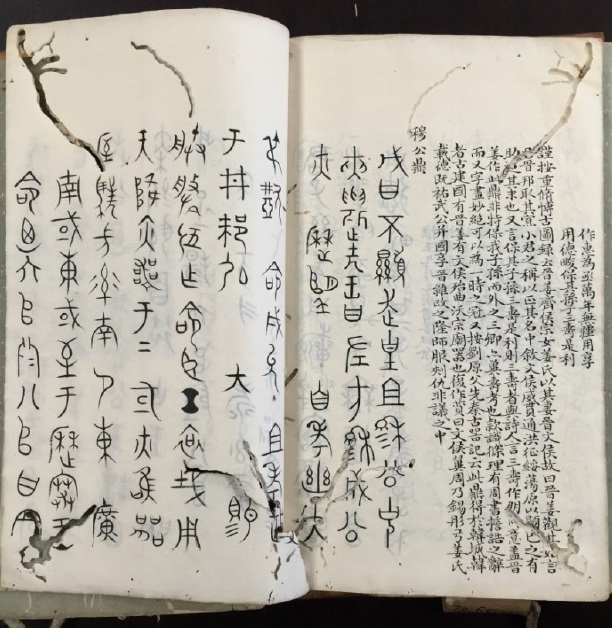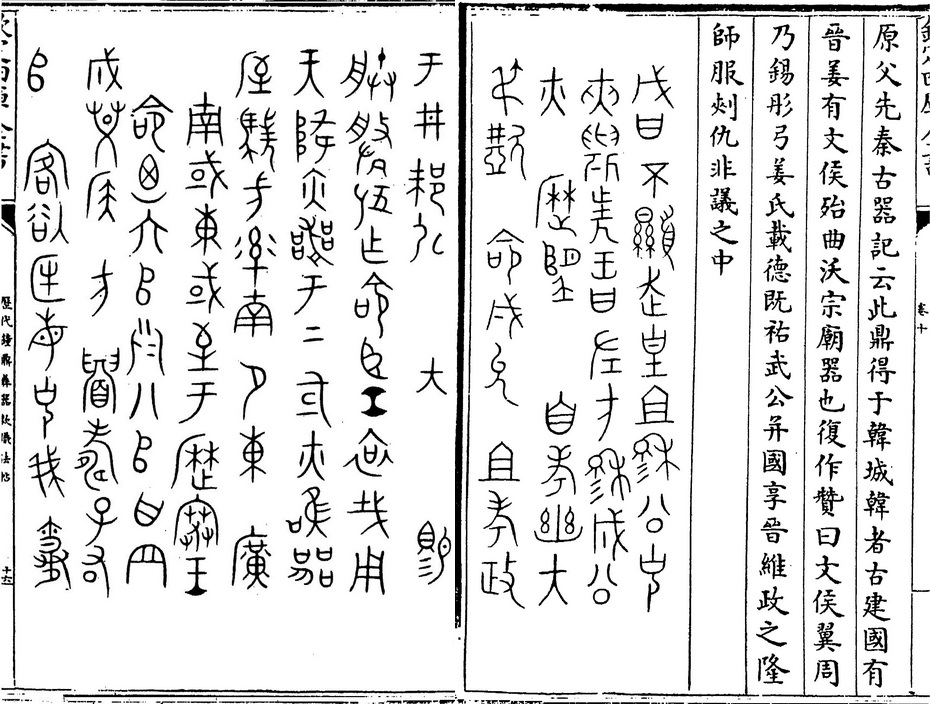Lidai zhongding yiqi kuanzhi fatie 歷代鐘鼎彝器款識法帖 is a catalogue of inscriptions on ancient bronze vessels and bells. The expression kuanzhi 款識 means inscription. The book of 20 juan length was compiled during the Southern Song period 南宋 (1127-1279) by Xue Shanggong 薛尚功 (fl. 1144), courtesy name Yongmin 用敏, from Qiantang 錢塘 (present-day Hangzhou 杭州, Zhejiang, and at that time the capital of the Song empire).
The catalogue reproduces the inscriptions of 510 metal objects from the oldest times to the Han period 漢 (206 BCE-220 CE) and transcribes the inscriptions – written in ancient styles like the large seal script (zhou 籀) or the small seal script (zhuan 篆) - into contemporary script, and gives further information on it. The editor does not provide any information on the vessels or tools themselves.
Many inscriptions are taken from earlier catalogues like Lü Dalin's 呂大臨 (c. 1042-c. 1090) Kaogutu 考古圖 and Wang Fu's 王黼 (1079-1126) Xuanhe bogu tu 宣和博古圖, while a great number (131) is not found in these two books, and a number of 96 texts not found at all in any other Song-period books on ancient bronze inscriptions, like Zhao Mingcheng's 趙明誠 (1081-1129) Jinshilu 金石錄, Huang Bosi's 黃伯思 (1079-1118) Dongguan yulun 東觀餘論, Dong You's 董逌 (fl. 1127) Guangchuan shuba 廣川書跋, Wang Qiu's 王俅 (c. 1170) Xiaotang jigu lu 嘯堂集古錄, Zhao Jiucheng's 趙九成 (?) Xu kaogutu 續考古圖, the book Shaoxing neifu guqi ping 紹興内府古器評 or Wang Houzhi's 王厚之 (1131-1204) Fuzhai zhongding kuanzhi 復齋鐘鼎款識.
Among the texts presented, some are derived from fake objects like a bronze plate (Bi Gan mu tongpan ming 比干墓銅盤銘) allegedly found in the tomb of Bi Gan 比干 from the Shang period 商 (17th-11th cent. BCE).
Most inscriptions were found on bronze vessels, but a smaller number came from other materials, like the "Zhou drums" (Zhou gu 周鼓, i.e. the famous stone drums 石鼓文), a jade seal from the Qin period 秦 (221-206 BCE; Qin xi 秦璽), a sound-stone (shiqing 石磬), and a jade tiger (yuhu 玉琥).
Even if Xue's book must be credited for its function as a pathbraker for research in ancient inscriptions, the "data base" of 500 texts is quite small (albeit nearly 80 per cent of the inscriptions known during the Song period are covered), and the scholarly level of research still very low.
The text of the catalogue was in 1144 incised into stone, and circulated as rubbings (tuoben 拓本) based on this fatiè 法帖 "model plate". Some fragments of early copies survive until today, for instance, ten leaves one owned by the Archives of the Grand Secretariat (Neige Daku 內閣大庫) and published by the Institute of History and Philology of the Academia Sinica in Taibei, Taiwan (Zhongyang Yanjiuyuan Lishi Yuyan Yanjiusuo 中央研究院歷史語言研究所) in fascimile form. Other Song-period fragments are owned by the Shanghai Library (Shanghai Tushuguan 上海圖書館) and the Institute of Archaeology of the Chinese Academy of Social Sciences (Zhongguo Shehui Kexueyuan Kaogu Yanjiusuo 中國社會科學院考古研究所).
The most important woodblock print of Xue's book was published in 1633 by Zhu Mouyin 朱謀垔 (reproduced in 1985 by Zhonghua Shuju 中華書局). The earliest Ming-period 明 (1368-1644) print dates from 1588 and was published by a certain Wanyu Shanren 萬嶽山人. Other editions were published in 1797 by Ruan Yuan 阮元 (1764-1849, Xiaolanghuanxianguan Studio 小瑯嬛仙館), 1807 by the Pingjinguan Studio 平津館 of Sun Xingyan 孫星衍 (1753-1818), and 1903 by Liu Shiheng 劉世珩 (1875-1926).
 |
 |
Inscription of the tripod Yigong ding 移公鼎 (fasc. 10), above: a high-quality Qing-period manuscript (Yu et al. 2016), below: the same inscripton as presented in the Siku quanshu edition. In the latter, the inscription bears no title. |
There are also several manuscript versions circulating, namely two from the Ming, and nine from the Qing period 清 (1644-1911; Yu et al. 2016). One manuscript version was produced by the Jiguge Studio 汲古閣 of Mao Yi 毛扆 (1640-1713) and published in 1719 by Lu Tongliang 陸桐亮. It was among the holdings of the scholar Liao Quansun 繆荃孫 (1844-1919) and was reproduced as a fascimile in 1985 by the Liao-Shen Press 遼瀋書社.
Xue's catalogue is included in the series Siku quanshu 四庫全書, albeit not among catalogues, but in the section on dictionaries and books on writing (xiaoxue 小學).